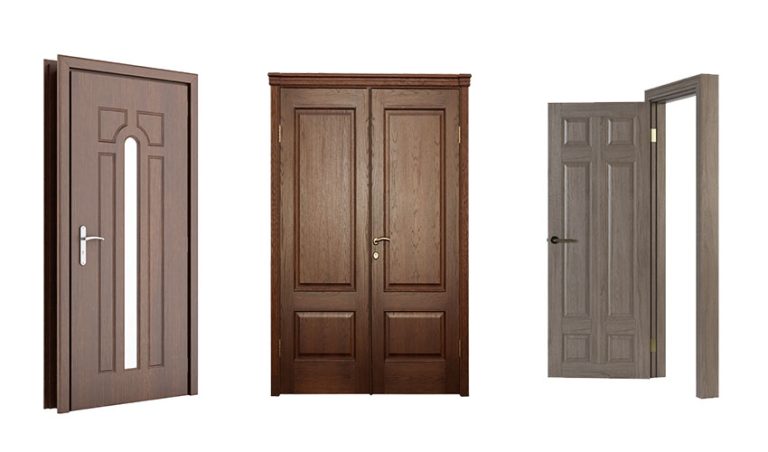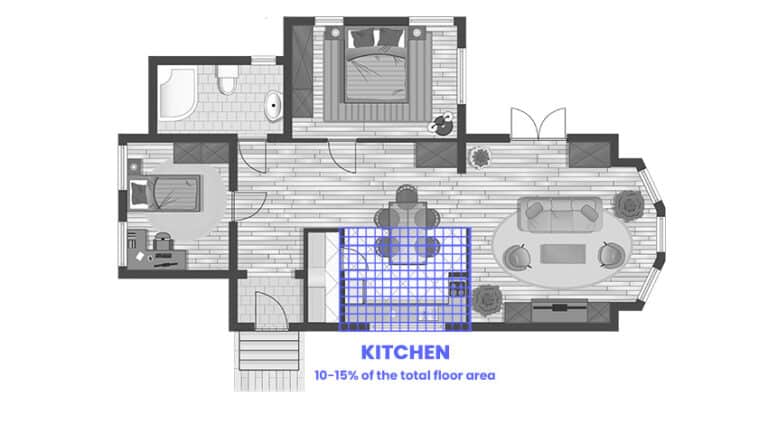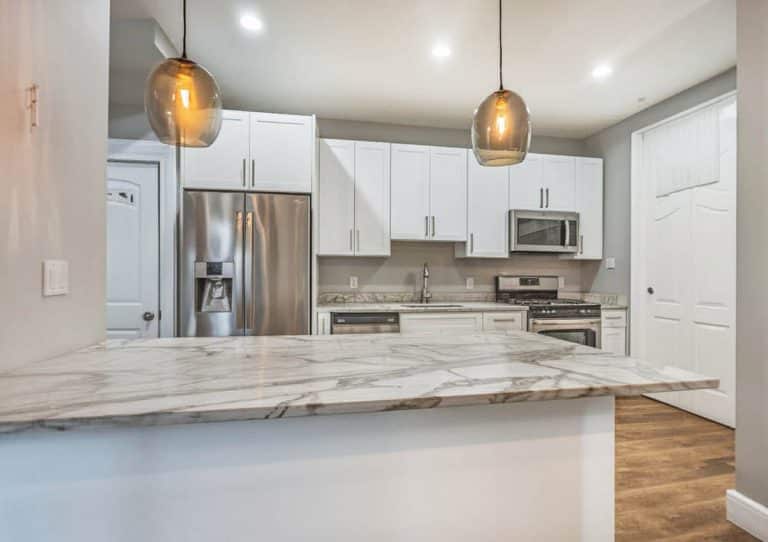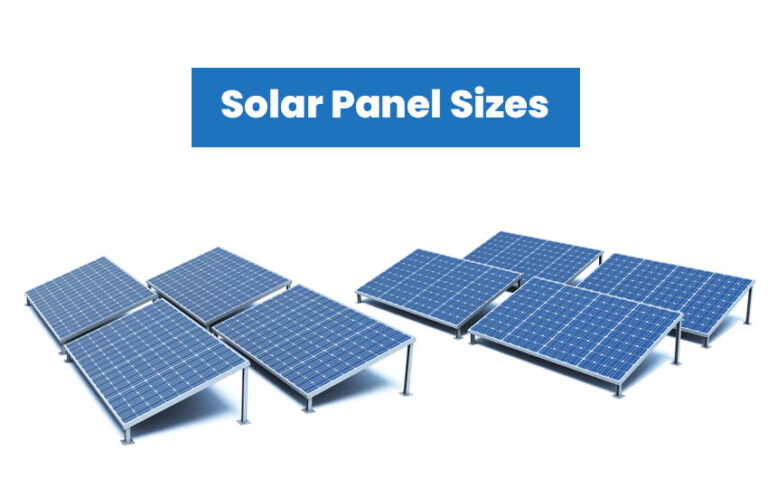What Are The Kitchen Island Size Guidelines?
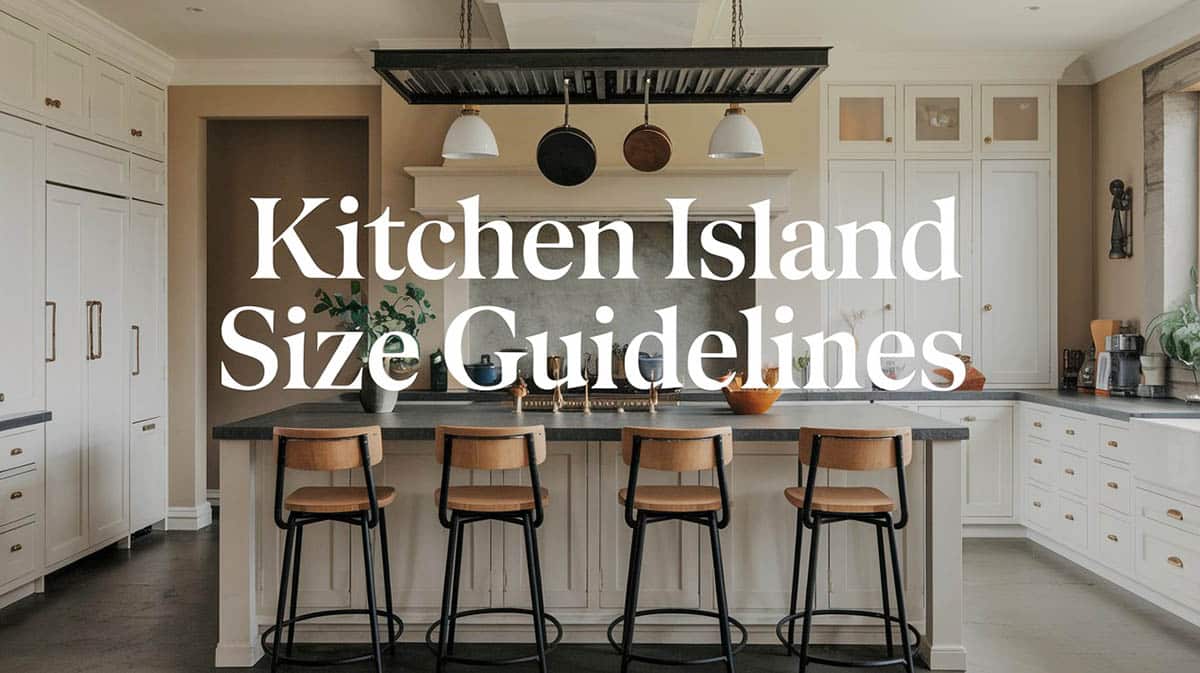
Kitchen islands are a hugely sought-after feature in the home. It has become an integral part of the kitchen where one can work or prepare food, store appliances or utensils, and do special tasks like baking. Additionally, the kitchen island has also become a “social hub” at home, where family and friends can gather, chat, and enjoy meals together. While in terms of design, it is often used as the focal point of a kitchen interior. If you plan on making this multi-functional built-in part of your home, it is important to know and follow the necessary measurements, recommended dimensions, and standard sizes in designing it.
Ensuring that your floor plan follows these requirements not only helps in achieving a pleasing aesthetic but also a well-planned layout that helps provide a smooth and effective workflow in the space. Below, we give you complete instructions for kitchen island size guidelines to help you plan and design the best one for your home.
How To Choose The Best Kitchen Island Size
While there is a list of recommendations for the standard measurements and dimensions of kitchen islands, there are many possibilities regarding their shape, size, and layout. There are several factors that you need to consider in choosing which kitchen island size is the best fit for your home:
Kitchen Size
The number 1 factor that you have to keep in mind when choosing the best kitchen island size for your home is square footage — in fact, these two are directly proportional to each other. The distances around it primarily determine an island’s size — so obviously, larger rooms can allow for bigger structures. Not all layouts can accommodate large kitchen islands with seating. Sometimes, a compact prep surface is all you can put in a small kitchen.
Relative to your kitchen’s size is scale. Whether your kitchen is small or large, you have to consider scale. A large prep station, for obvious reasons, will look more balanced if placed in a large space. Even if you follow the standard dimensions, if you put a tiny island in a very spacious kitchen, it can look off and dwarfed. By contrast, a large island can crowd a compact kitchen.
Kitchen Layout or Shape
The size of your island is also dependent on the layout of your kitchen. The layout of your kitchen — whether U shaped, L shaped, galley, or one-wall, will help you determine whether adding an island to your space will be effective or obstructing. An island is more likely suitable for kitchens that are U shaped and L shaped. However, they will also work in one-wall layouts, provided the surrounding space is large enough.
Galley kitchens, which consist of two rows of cabinets facing each other, creating an inner passage between them, may not accommodate an island. It is also significant to consider the layout and the existing conditions of your kitchen to ensure that all the needed clearances will work.
Island Function
If you have the luxury of space in your home, another basis that you can use for the size of your kitchen island is its intended function. How do you plan to use your island? Do you plan on using it as a prep station? A prep island can be as simple as an extra, blank countertop space where you can chop vegetables and prepare other ingredients for cooking.
Do you need an integrated sink in the island for washing your hands and produce? If you are into baking, you can use it for kneading dough, too. You can also add a butcher’s block if you like. Do you plan on including seating? A bar island can be used for enjoying simple meals, snacks, or even a cup of coffee. If you do not have a dedicated home office, a central countertop with seating can also be utilized as a workspace or study area.
The kitchen island offers a lot of forms and functions. If you plan on using it as an ultimate multi-functional unit for all the reasons enumerated above, you might need to choose a more expansive size for your home.
Kitchen Island Size Guidelines Design Tip: If your kitchen is less than 13 feet wide, we do not recommend adding an island to the space. There must at least be 10 feet , 3 meters or 120“ of open space to accommodate an island without making the space feel too cramped.
Standard Size for Kitchen Islands
How wide should a kitchen island be? The standard width is 24″ or 60 centimeters. Some islands are also 3 feet wide, but if you need more space for dining or food preparation, you can go for something a bit larger. If you are planning on adding a cooktop and a sink on the island, you will need a kitchen island width of approximately 7 feet or 84″ or 213 centimeters.
Regarding the distance from a table to the island, the distance should be 42″ to 48″ clearance. In addition, for the sink faucet to the island it is recommended to have a clearance of 42″ to 48″.
How deep should a kitchen island be? The standard depth is 2 feet or 24″ or 60 centimeters.
What is the standard height of a kitchen island? The standard height is 91 centimeters or 36″.
This is the recommended height if the countertop will be used primarily for food preparation and cooking. If you intend to use it for dining, raise the height to 106.68 centimeters or 42″.
How to Determine Island Dimensions
How much space do you need between an island and a counter? Clearances and distances between furniture pieces and built-ins are important in planning interiors because they help ensure an efficient workflow in the space. If you do not leave enough room on all sides, you won’t be able to move around easily in the space.
You need to have a distance of at least one meter or 40″ between the main kitchen work counter/cabinets and the countertop. This ensures that you can walk around the island easily and at the same time allows for at least two persons to use the space comfortably at the same time (one person can still walk behind another person standing in front of the island).
A 3.3-foot or one meter clearance also ensures that all cabinets can be opened easily without limitation and obstruction. When looking at counter size guidelines for tight spaces, the lowest amount of clearance that you can go for is 90 centimeters or 35″. You can push this to 80 centimeters or 31″ only if you plan on installing a minimum sized island (1 meter x 1 meter).
On the other hand, there is also such a thing as too much distance between an island and the main kitchen counter. For example, having a clear distance of 1.5 meters or 60″ can feel a bit off in the space and will also lessen the efficiency of the work flow since you have to take a few more steps to travel from one workstation to another.
How much clearance do you need around a counter? In reference to the required distance between an island and the main kitchen counter, the same standard applies to the amount of clearance that you need around it (the island).
Clearances help with traffic patterns, work flows, work triangles, and accessibility. There must be at least one meter or 40″ clear space around the counter to ensure a comfortable work and traffic flow in the space.
If you do not keep the surrounding space of your island proportionate to the island’s dimensions, you risk creating an inefficient workflow in the space. Whether the clearance zone is too big or too small, it will be hard to move around it. Clearances that are wider than 120 centimeters, 1.2 meters, or 47″ are too much and not user friendly.
How much space do you need per person for seating at a countertop? For comfortable seating on a countertop, you need to take into consideration the amount of space you allot for each person who’s going to use it.
A good general rule to follow is to have at least an adequate space of 60 centimeters or 24″ per person to allow for enough elbow room. This also ensures that the users can sit comfortably and use the island without bumping into each other.
If your kitchen has a limited area, the least space you can allot is 50 centimeters or 19.7″ per person. This is also adequate if the seating will be used primarily by kids. Anything less than 50 centimeters will be uncomfortable to use.
How much overhang should a counter have for seating? The overhang is the part of a kitchen countertop that extends to cover the under cabinets and drawers This prevents any spills, crumbs, or other stuff from falling off the countertop and damaging the cabinets below.
For islands, the overhang is the part of the countertop that extends to the side where the seating is located. An overhang is ideal if you want a breakfast bar on your island, where you can enjoy snacks and simple meals.
Having enough space for the island’s overhang is important because it ensures that there is enough leg room for the sitting person and also makes sure that there is sufficient space where you can tuck your bar stools under.
The standard overhang for countertops is 30 centimeters or 12″. You can go for a lower amount of overhang, depending on the type of bar stools used. The minimum amount of overhang for some types of seating is 20 centimeters or 7.87″.
If you have more space, you can adjust this to 45 centimeters or 18″ so you don’t have to pull the stools far into the aisle for more knee room. However, having a bigger overhang means you will need extra support for the freestanding structure, such as legs or L shaped brackets.
In addition to these standards, custom islands may have different overhang measurements depending on their thicknesses. The thicker the countertop is, the larger the unsupported overhang can be.
Countertops that are 12mm thick can only have a maximum 20 centimeters or 7.87″ unsupported overhang, while 20mm thick designs can have an overhang of a maximum 25 centimeters or 10″. Thicker countertops, which are 30mm in size, can go for the standard 30 centimeters or 12″ unsupported overhang.
Average Island Measurements
Here are counter size guidelines for the average sizes that you can use when designing your home: The average size of a countertop is 1 meter x 2 meters (100 cm x 200 cm or 40″ x 80″).
This would typically have a surrounding clearance zone of 1 meter. This surface size is enough space for prep work like cutting, slicing, cleaning fresh produce, and kneading dough for baking. An average-sized central hub can also accommodate a small 18″ sink.
Typical Counter Size Guidelines
Here are some of its common dimensions:
Prep islands without seating
– 24 inches W x 24 inches D x 36 inches H (60cm D x cm D x 90cm H)
– 36 inches W x 24 inches D x 36 inches H (90cm D x 60cm D x 90cm H)
– 48 inches W x 24 inches D x 36 inches H (120cm D x 60cm D x 90cm H)
– 60 inches W x 24 inches D x 36 inches H (150cm D x 60cm D x 90cm H)
– 72 inches W x 24 inches D x 36 inches H (180cm D x 60cm D x 90cm H)
– 84 inches Wx 24 inches D x 36 inches H (210cm D x 60cm D x 90cm H)
*height may vary up to 42″ (105 centimeters)
Islands with bar stool seating (overhang included):
– 48 inches W x 36 inches D x 36 inches H (120cm D x 90cm D x 90cm H)
– 72 inches W x 36 inches D x 36 inches H (180cm D x 90cm D x 90cm H)
– 96 inches W x 36 inches D x 36 inches H (240cm D x 90cm D x 90cm H)
– 120 inches W x 36 inches D x 36 inches H (300cm D x 90cm D x 90cm H)
– 144 inches W x 36 inches D x 36 inches H (360cm D x 90cm D x 90cm H)
*depth can vary anywhere from 8″ to 18″ (20 cm to 45 cm)
*height may vary up to 42″ or 105 centimeters
Minimum Sized Island
Although there is an average counter, you can still find a way to squeeze in a compact island in a small kitchen, provided the proper clearances are observed. The recommended minimum size of an island counter is 1 meter x 1 meter or 40″ x 40″. Despite being small, this size will still allow for a practical prep space.
You also have the option of integrating appliances into the layout. Anything smaller than the minimum may be hard to work on and less functional. The typical clearance for a minimum-sized countertop is 80 centimeters or 31″ — which is suitable for one user of the space. This is the smallest possible distance for compact islands, to allow for a safe and unobstructed passage.
Sizes Based on the Number of Island Seats
One of the most common features of a counter is a space for bar stool seating. Many homeowners envision their islands as the social hub of their home, where they can enjoy simple meals together as a family and entertain friends. The number of seats that you intend to include at your countertop also plays a significant role in determining its size.
A kitchen island isn’t “one size fits all.” It is important to know the different recommended island sizes to ensure that each of the users can move freely without bumping into each other while dining.
How do you compute the surface size based on the number of seats? We have mentioned earlier in this article that there must be at least 60 centimeters or 24″ allotted for each person to have enough elbow room while sitting at the counter. However, by using kitchen islands with bench seating one may be able to accommodate more diners.
Keeping this measurement in mind, let’s now do the math:
If you are designing and installing a new layout, to get the right counter width, multiply 23.6″ or 60 centimeters by the number of persons you want to seat at the island. For example, if you want to seat three people, you should be looking at having an island width of around 71″ (23.6″ x 3 persons = 70.8″) or 180 centimeters (60 cm x 3 persons = 180 cm).
If you already have an existing structure and want to know how many seats you can fit in it, First measure your existing surface and take note of its width and then divide its width by 23.6″ or 60 centimeters. For example, if you have a counter with a width of 7.87 ft or 2.4 meters, this means you can put 4 chairs in it. (94.4″ / 23.6″ = 4 people) or ( 240 cm / 60 cm= 4 persons).
Standard Sizes Based on Island Bar Stool Seating
The recommended overall depth for islands with seating is 90 centimeters or 36 inches. Simply put, this is the resulting measurement you get when the standard depth ( 60 cm or 24 inches) and the standard overhang (30 cm or 12 inches) are combined.
Here is a list of the standard counter size guidelines based on seating:
Size for 2 Stools
The standard size for an island with two stools is 120 centimeters (48 inches) width x 90 centimeters depth (36 inches)
Size for 3 Stools
The standard size for an island with three stools is 180 centimeters (72 inches) width x 90 centimeters depth (36 inches)
Size for 4 Stools
The standard size for a standalone counter with four stools is 240 centimeters (96 inches) width x 90 centimeters depth (36 inches)
Size for 6 Stools
The standard size for a standalone counter with six stools is 360 centimeters (144inches) width x 90 centimeters depth (36 inches)
For more related designs visit our page about the types of kitchen islands.

